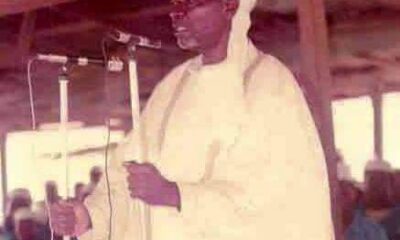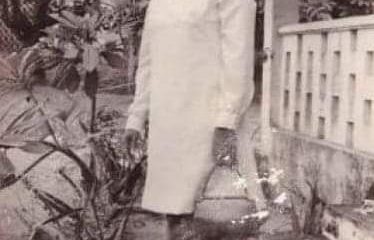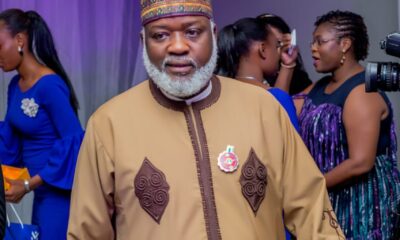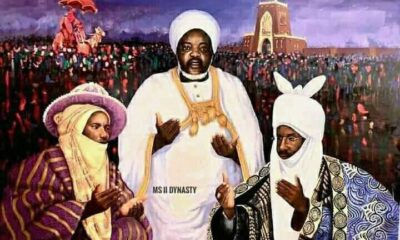History
Meet The Only American President Who Served Two Non Consecutive Terms
History
Brief History Of Modakeke
Modakeke is a town in Osun State, South West Nigeria, with a population of close to three hundred thousand people.
The Modakekes are also known as the Akoraye and have a history of valor at war and are prosperous farmers.
With the fall of the Oyo Empire to the Fulani, the Yoruba kingdom was thrown into confusion and the inhabitants of the Old Oyo were dispersed and started new settlements all around Yoruba land.
Fleeing southwards in search of new abodes after the fall of the Oyo Empire, the Oyos started settling among the Ifes in 1834.
As the Romans of old, they were soldier-farmers. They were hardy as soldiers and industrious as farmers.
Having lost all their possessions in their hasty flight, they started life in Ife by doing menial jobs to enable them eke out a living.
The reigning Ooni of Ife, Oba Akinmoyero was said to have received them well.
They started growing and producing different types of food crops on farmlands given to them by their hosts.
A good number of them got recruited into Ife’s weak army and it was through their gallantry that Ife had its territory extended to Alakowe, its present boundary with Ilesa.
Prior to the arrival of the Oyos, Ijesha land extended to the present location of the Palace of the Ooni of Ife.
This is why the Palace area is known as Enuwa (Enu Owa) until today.
Ooni Akinmoyero gave the displaced Oyo an expanse of land to stay outside the walls of Ife,the place given to the Modakekes was home to a species of bird called Ako (Stork), Hence the origin of the appellation AKORAYE(The stork has a place).
It was also customary for the storks at the location to chirp and sing the rhyme Mo-da-ke-ke-ke-ke which was most of the time heard by the Ifes and it was decided that the new settlement would be called MODAKEKE
History
History of the Ajanakus Family in Ilesa, Osun State, Nigeria
Early 19th Century: The Beginning
The Ajanakus family traces its roots back to the early 19th century in Ilesa, Osun State, Nigeria. The family’s progenitor, Pa Ajanaku, was known for his wisdom and leadership within the local community. He was a respected farmer and trader, contributing significantly to the agrarian economy of Ilesa.
Late 19th Century: Expansion and Influence
By the late 1800s, the Ajanaku family had expanded both in size and influence. Pa Ajanaku’s descendants continued his legacy, establishing themselves as prominent figures in agriculture and local commerce. The family became known for their cultivation of cocoa, a key cash crop in the region, which boosted their economic standing.
Early 20th Century: Community Leadership
In the early 1900s, the Ajanaku family began to take on more formal leadership roles within Ilesa. Members of the family held various chieftaincy titles and were involved in the administration of the town. Their influence extended to education, as they were instrumental in the establishment of local schools, promoting literacy and learning in the community.
Mid-20th Century: Modernization and Political Involvement
The mid-20th century saw the Ajanaku family adapting to the changing political landscape of Nigeria. They played key roles during the colonial period and the struggle for independence. Family members were active in local and regional politics, advocating for the rights and development of the Ilesa community.
Late 20th Century: Economic Diversification
As Nigeria gained independence in 1960, the Ajanaku family diversified their economic activities. They ventured into various industries, including manufacturing and real estate. Their entrepreneurial spirit contributed to the economic growth of Ilesa and Osun State.
21st Century: Legacy and Continuity
Today, the Ajanaku family remains a pillar of the Ilesa community. They continue to uphold their legacy of leadership, community service, and economic contribution. The younger generation has embraced modern professions, including law, medicine, and technology, while still honoring the family’s historical roots in agriculture and commerce.
The Ajanakus’ enduring legacy in Ilesa is a testament to their resilience, adaptability, and commitment to their community, reflecting the broader historical and cultural evolution of Osun State and Nigeria as a whole.
Ruth world best
History
Margaret Walker: Trailblazing Poet, Scholar, and Activist
Margaret Walker was born on July 7, 1915, in Birmingham, Alabama was a college student at the age of 15 when she begin writing poetry. She received a BA from Northwestern University in 1935 and an MA from the University of Iowa in 1940. In 1936 she joined the Federal Writers’ Project in Chicago, where she became friends with Richard Wright and joined his South Side Writers Group.
In 1941 Walker became the first African American poet to receive the Yale Younger Poets Prize, for her debut collection For My People (Yale University Press, 1942). She was also the author of the poetry collections This Is My Century: New and Collected Poems (University of Georgia Press, 1989), October Journey (Broadside Press, 1973), and Prophets for a New Day (Broadside Press, 1970).
Walker married Firnist Alexander in 1943, and together they had four children. In 1949 they moved to Mississippi, where she joined the faculty at Jackson State College. She returned to the University of Iowa for her doctoral studies and received a PhD in 1965. The following year, she published her dissertation as a novel, Jubilee (Houghton Mifflin, 1966).
In 1968 Walker founded the Institute for the Study of the History, Life, and Culture of Black People at Jackson State College. As director of the institute, which was later renamed the Margaret Walker Center, she organized the 1971 National Evaluative Conference on Black Studies and the 1973 Phillis Wheatley Poetry Festival.
After Walker retired from teaching in 1979, she published On Being Female, Black, and Free (University of Tennessee Press, 1997), a collection of personal essays, and Richard Wright: Daemonic Genius (Warner Books, 1988), a work of nonfiction informed by her friendship with Wright. Margaret Walker died of cancer on November 30, 1998, in Jackson, Mississippi.
-

 Features3 years ago
Features3 years agoHow I Became A Multimillionaire In Nigeria – Hadiza Gabon
-

 Opinion2 years ago
Opinion2 years agoOn The Kano Flyovers And Public Perception
-

 History3 years ago
History3 years agoSheikh Adam Abdullahi Al-Ilory (1917-1992):Nigeria’s Islamic Scholar Who Wrote Over 100 Books And Journals
-

 Opinion4 years ago
Opinion4 years agoKano As future Headquarters Of Poverty In Nigeria
-

 History3 years ago
History3 years agoThe Origin Of “Mammy Market” In Army Barracks (Mammy Ochefu)
-

 News2 years ago
News2 years agoFederal University Of Technology Babura To Commence Academic Activities September
-

 Opinion3 years ago
Opinion3 years agoMy First Encounter with Nasiru Gawuna, the Humble Deputy Governor
-

 Opinion3 years ago
Opinion3 years agoKhalifa Muhammadu Sanusi II, A Phoenix Rises